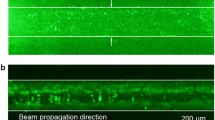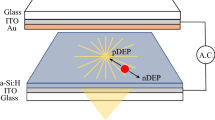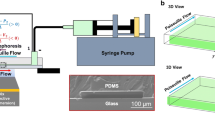Abstract
This work presents the dielectrophoretic manipulation of sub-micron particles suspended in water and the investigation of their optical responses using a microfluidic system. The particles are made of silica and have different diameters of 600, 450, and 250 nm. Experiments show a very interesting feature of the curved microelectrodes, in which the particles are pushed toward or away from the microchannel centerline depending on their levitation heights, which is further analyzed by numerical simulations. In doing so, applying an AC signal of 12 Vp–p and 5 MHz across the microelectrodes along with a flow rate of 1 μl/min within the microchannel leads to the formation of a tunable band of particles along the centerline. Experiments show that the 250 nm particles guide the longitudinal light along the microchannel due to their small scattering. This arrangement is employed to study the feasibility of developing an optofluidic system, which can be potentially used for the formation of particles-core/liquid-cladding optical waveguides.






Similar content being viewed by others
References
Bernini R, De Nuccio E, Minardo A, Zeni L, Sarro PM (2008) Liquid-core/liquid-cladding integrated silicon ARROW waveguides. Opt Commun 281(8):2062–2066
Bohren CF, Huffman DR (1983) Absorption and scattering of light by small particles. Wiley, New York
Cummins CM, Koivunen ME, Stephanian A, Gee SJ, Hammock BD, Kennedy IM (2006) Application of europium(III) chelate-dyed nanoparticle labels in a competitive atrazine fluoroimmunoassay on an ITO waveguide. Biosens Bioelectron 21(7):1077–1085
de Matos CJS, Cordeiro CMB, dos Santos EM, Ong JSK, Bozolan A, Cruz CHB (2007) Liquid-core, liquid-cladding photonic crystal fibers. Opt Express 15(18):11207–11212
Doh I, Cho YH (2005) A continuous cell separation chip using hydrodynamic dielectrophoresis (DEP) process. Sens Actuators A 121(1):59–65
Hahn DW (2009) Light scattering theory. openpdf.com/ebook/light-theory-pdf.html, University of Florida, Gainesville
Hughes MP, Morgan H, Flynn MF (1999) The dielectrophoretic behavior of submicron latex spheres: Influence of surface conductance. J Colloid Interface Sci 220(2):454–457
Jones TB (2003) Electromechanics of particles. Cambridge University Press, Cambridge
Kalantar-zadeh K, Fry B (2007) Nanotechnology enabled sensors. Springer, New York
Kang YJ, Li DQ, Kalams SA, Eid JE (2008) DC-dielectrophoretic separation of biological cells by size. Biomed Microdev 10(2):243–249
Kerker M (1969) The scattering of light and other electromagnetic radiation. Academic, New York
Khlebtsov BN, Khanadeev VA, Khlebtsov NG (2008) Determination of the size, concentration, and refractive index of silica nanoparticles from turbidity spectra. Langmuir 24(16):8964–8970
Khoshmanesh K, Zhang C, Tovar-Lopez FJ, Nahavandi S, Baratchi S, Kalantar-zadeh K, Mitchell A (2009) Dielectrophoretic manipulation and separation of microparticles using curved microelectrodes. Electrophoresis 30(21):3707–3717
Khoshmanesh K, Zhang C, Tovar-Lopez FJ, Nahavandi S, Baratchi S, Mitchell A, Kalantar-zadeh K (2010) Dielectrophoretic activated cell sorter based on curved microelectrodes. Microfluids Nanofluidics. doi:10.1007/s10404-009-0558-7
Khusid B, Acrivos A (1995) Effects of conductivity in electric field-induced aggregation in electrorheogical fluids. Phys Rev E 52(2):1669–1693
Kumar A, Acrivos A, Khusid B, Jacqmin D (2007) Electric field-driven formation of particle concentration fronts in suspensions. Fluid Dyn Res 39(1–3):169–192
Lao CS, Liu J, Gao PX, Zhang LY, Davidovic D, Tummala R, Wang ZL (2006) ZnO nanobelt/nanowire Schottky diodes formed by dielectrophoresis alignment across Au electrodes. Nano Lett 6(2):263–266
Morgan H, Green NG (2003) AC electrokinetics: colloids and nanoparticles. Research Studies Press Ltd., Baldock
Ofir Y, Samanta B, Rotello VM (2008) Polymer and biopolymer mediated self-assembly of gold nanoparticles. Chem Soc Rev 37(9):1814–1823
Paschotta R (2008) Encyclopedia of laser physics and technology. Wiley-VCH, Berlin
Conroy RS, Mayers BT, Vezenov DV, Wolfe DB, Prentisst M and GMW (2005) Optical waveguiding in suspensions of dielectric particles. Appl Opt 44(36):7853–7857
Schmidt BS, Yang AHJ, Erickson D, Lipson M (2007) Optofluidic trapping and transport on solid core waveguides within a microfluidic device. Opt Express 15(22):14322–14334
Stober W, Fink A, Bohn E (1968) Controlled growth of monodisperse silica spheres in micron size range. J Colloid Interf Sci 26(1):62–69
Wang SL, Fang ZL (2005) Integrating functional components into capillary electrophoresis systems using liquid-core waveguides. Anal Bioanal Chem 382(8):1747–1750
Webb KJ, Li J (2005) Resonant slot optical guiding in metallic nanoparticle chains. Phys Rev B 72(20):201402
Wolfe DB, Conroy RS, Garstecki P, Mayers BT, Fischbach MA, Paul KE, Prentiss M, Whitesides GM (2004) Dynamic control of liquid-core/liquid-cladding optical waveguides. Proc Natl Acad Sci USA 101(34):12434–12438
Wolfe DB, Vezenov DV, Mayers BT, Whitesides GM (2005) Diffusion-controlled optical elements for optofluidics. Appl Phys Lett 87:181105
Yang AHJ, Erickson D (2008) Stability analysis of optofluidic transport on solid-core waveguiding structures. Nanotechnology 19(4):045704
Zhang C, Khoshmanesh K, Mitchell A, Kalantar-zadeh K (2009) Dielectrophoresis for the manipulation of micro/nano particles in microfluidic systems. Anal Bioanal Chem 396(1):401–420
Author information
Authors and Affiliations
Corresponding author
Appendices
Appendix 1
See Fig. 7.
Appendix 2
The electro-convective force induced by Joule heating effect is ignored due to application of a low conductivity medium, which produces a small temperature rise of 0.012 K in the medium, as (Morgan and Green 2003):\( \Updelta T \approx {\frac{{\sigma_{\text{m}} V_{\text{rms}}^{2} }}{k}} = {\frac{{2 \times 10^{ - 4} \times 6^{2} }}{0.6}} = 0.012\;K, \), where k is the thermal conductivity of water. Similarly, the electro-convective force induced by light heating is ignored due to the low power of the incident beam, which produces a small temperature rise of 0.014 K in the medium as below:\( \Updelta T \approx {\frac{{{\text{power}}_{\text{light}} }}{{\rho_{\text{m}} QC_{\text{m}} }}} = {\frac{{1 \times 10^{ - 3} }}{{10^{3} \times 1.66 \times 10^{ - 8} \times 4.18 \times 10^{3} }}} = 0.014\;K, \) where Q is the flow rate, and C m is the thermal capacity of water. Finally, the optical radiation pressure force is ignored due to the low power of the incident beam, which induces a small electric field of 18.5 kV/m in the microchannel, as (Paschotta 2008): \( E_{\text{light}} = \left( {{\frac{2I}{{c\varepsilon_{0} n_{\text{d - core}} }}}} \right)^{0.5} = \left( {{\frac{{2 \times 6.6 \times 10^{5} }}{{3 \times 10^{8} \times 8.85 \times 10^{ - 12} \times 1.475}}}} \right)^{0.5} = 18.5\;{\text{kV/m}}, \) where I is the intensity of light, and c is the speed of light. The I is calculated assuming that all energy is concentrated along the core region with an approximated dimensions of 30 × 50 μm2.
Appendix 3
See Fig. 8.
a Increasing the applied voltage to 20 Vp–p while operating at 5 MHz, increased the negative DEP force and pushed the particles toward the sidewalls. b Increasing of medium flow rate to 2 μl/min destabilized the funneling of particles and caused the width of the narrow band to harmonically change between the consequent pairs.
Appendix 4
The scattering efficiency of particles varies with respect to the influential parameters of an optical system, including the refractive indexes of particles and surrounding medium, the diameter of particles, and the wavelength of the incident light. It can be calculated using the Mie scattering theory (Bohren and Huffman 1983; Hahn 2009), as follows:
where λ is the relative scattering wavelength, defined as:
In which, λlight is the wavelength of the incident light, and n d-m is the refractive index of the medium (or cladding for an optical waveguide). On the other hand, an and bn are defined as below:
where Ψ and ξ are the Ricatti–Bessel functions (Kerker 1969), n d-m is the refractive index of the particles (or core for our case), which is the cladding for an optical waveguide, and α is the size parameter defined as:
From the above equations, it is clear that the scattering efficiency varies with respect to refractive indexes of particles and surrounding medium, the diameter of particles, and the wavelength of the incident light.
Rights and permissions
About this article
Cite this article
Khoshmanesh, K., Zhang, C., Campbell, J.L. et al. Dielectrophoretically assembled particles: feasibility for optofluidic systems. Microfluid Nanofluid 9, 755–763 (2010). https://doi.org/10.1007/s10404-010-0590-7
Received:
Accepted:
Published:
Issue Date:
DOI: https://doi.org/10.1007/s10404-010-0590-7






